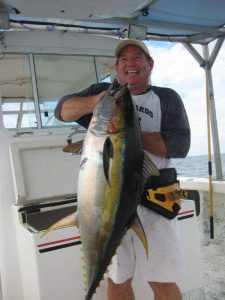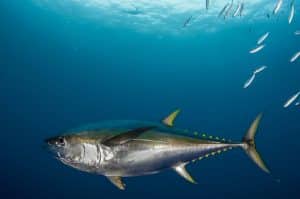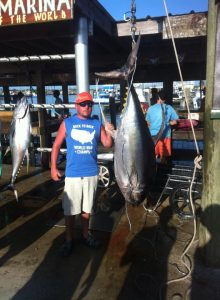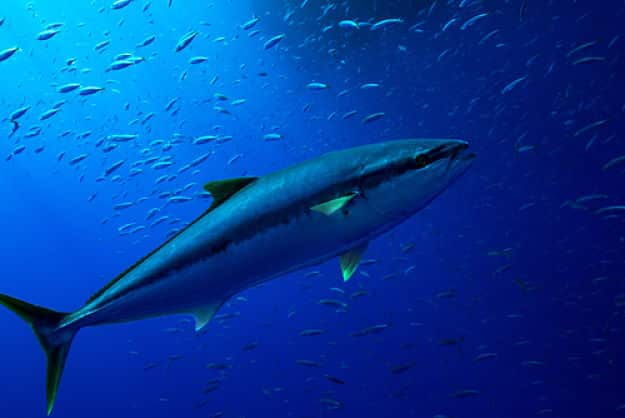Catching Yellowfin Tuna
Yellowfin tuna are well known for their physical beauty and powerful swimming, however, the similar appearance across the different varieties of tunas can lead to some confusion over identification. The albacore, bigeye, bluefin and yellowfin tuna are all football shaped and have a streamline body with shimmers of silver on their sides and darker colorations by their dorsal. The yellowfin has a dark blue dorsal surface while it can appear brownish in the water. True to their name, the yellowfin tuna have yellow in their fins and a shiny, golden yellow along their sides but coloration alone won’t allow you to correctly identify the different species of tuna. A key feature to identify a yellowfin tuna is the length of their pectoral fins. Each species has a particular “design” to their pectoral fins that identifies them: The yellowfin’s pectoral fin reaches the beginning of their second dorsal fin while the albacore pectoral fin always goes beyond the start of the second dorsal and the bluefin pectoral fin never reaches the second dorsal fin. The combination of color and pectoral fin size should give you a clear identification in most cases.
Size of the Yellowfin
Yellowfin tuna grow faster than the bluefin tuna, but do not reach the large size of their giant cousin. The largest yellowfin tuna on record was 388 lbs. And was caught in Mexico in 1977. The growing cycle for a yellowfin tuna 8-10 pounds at one year, age 2 about 35 lbs. and at 3 years old about 75 pounds. By 4 years old a yellowfin will averages about 130 lbs and can on average get as large as 200 lbs.
Angling and Handling Tips

Tackle Needed
Both methods use similar fishing tackle. Yellowfin typically range between 30-80 pounds, so use high quality 30, 50, or 80 pound-class reels, rods and line to fish for these beauties. Yellowfin that exceed 100 pounds are matched well with the 80 pound class gear. Lighter tackle can be used and is gaining popularity, but you better be prepared for a fight if you want to land a 150 lb. yellowfin tuna with 30 pound class tackle. Once you’ve hooked a yellowfin, rods are transferred to the angler wearing a gimbal belt and/or back harness. This allows for a “stand-up” fish fighting technique. A good position for an experienced angler but one that can quickly fatigue an inexperienced angler faced with a large tuna. The excitement generated in the cockpit as multiple yellowfin tuna strike and rip line off the reels is the highlight of sport fishing for yellowfin tuna.
Catching Yellowfin is Exciting

Louisiana’s Yellowfin Tuna
Yellowfin tuna is an abundant tropical tuna found throughout the Gulf of Mexico but caught most often off the shores of Louisiana. Yellowfin tuna are considered a single species in all oceans. However, the relationships between distinct seasonal aggregations of yellowfin within ocean basins are not well described. In the western Atlantic Ocean, fisheries have developed to target aggregations of yellowfin tuna in the Gulf of Mexico, Caribbean Sea, and along the Continental Shelf and slope waters from Hatteras to Cape Cod. Much larger harvests occur at fishing grounds in the east Atlantic. Yellowfin are exposed to fisheries in Massachusetts only off the south side of Cape Cod, where seasonal warming and Gulf Stream influences allow yellowfin to range over the Continental Shelf to forage during the summer.
So with yellowfin tuna fisheries around the world what makes the Louisiana’s yellowfin fishery so unique? Well just about everything, from environment to tuna behavior.

North America’s largest river flows out against Gulf Stream eddies (the Loop Current), and these currents meet above deep nearshore canyons along a shelf margin that is littered with FADs (oil rigs). Yellowfin tuna recreational catches out of Louisiana on a day charter fishing trip can, at times, resemble what you’d see on a Pacific long-range tuna trip off Mexico.
But one thing that really stands out is the lengthy season: You can catch yellowfin tuna off southeast Louisiana all year. Whether anglers are live-bait fishing with pogie fish, chumming by shrimp boats or natural bottom features, or throwing topwater lures near surface-feeding whale sharks, there’s always action available.
Clues about the yellowfin tuna’s life history in the Gulf of Mexico tell their story from adults in spawning condition, day-old larvae caught during surveys, juvenile tunas just months old, and multiyear tag returns from adults recaptured in almost the exact same area they were released. The data suggests that some yellowfin tuna might spend a whole lifetime in the Gulf of Mexico. Perhaps not the picture you’d expect for a highly migratory species?
In response to the importance of the Gulf of Mexico yellowfin tuna to Louisiana-based user groups and the lack of biological information, the Louisiana Department of Wildlife and Fisheries (LDWF) began a comprehensive yellowfin-research program.
Tagging Tuna

Recreational Fishery Regulations
Both the recreational and commercial fisheries for yellowfin tuna are regulated by the National Marine Fisheries Service (NMFS). Click here for more information, or call 1-888-USA-TUNA.




